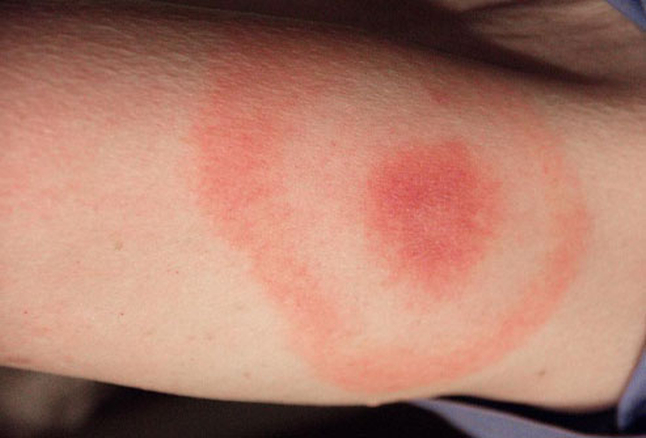To panic or not to panic? Menlo Park pediatrician Margaret Miller, MD, of Burgess Pediatrics, tackles a hot summer topic: Lyme disease.
As a parent, there are so many health threats that we vaguely hear about from others. Some are clearly irrelevant, but others concern us; for many people, Lyme disease falls into that worrisome category. There are so many different stories circulating, so much fear and so much confusion. In this short article, I would like to try to clarify what we know in medicine about Lyme disease.
Lyme disease comes from a tick. It is only found in certain types of ticks in certain regions of the country, and not all ticks are infected with the spirochete (a type of bacteria), which was discovered in 1982. There are more and more cases identified as awareness increases and we become better at diagnosing the problems associated with this bacteria.
The best approach is to think of preventing tick exposure and arming yourself with valid information about what to do if you find a tick on yourself or your child. There are infected ticks in the Bay Area, but far fewer than on the East Coast; some say you are 10 times less likely to encounter one here than on the other side of the country.
About 15-20% of young ticks are infected with the spirochete, while in adult ticks it’s only about 1-2%. In the spring and early summer, tick exposure increases due to more people being outside, but ticks are present all year in the Bay Area as a result of our mild climate. The environment you are in determines much of the risk. You find ticks more often in dense, dark woodlands where they find their preferred food, and not in more open, sunny areas. In Northern California, you find more ticks around logs, so it’s safer to sit on the leafy ground than on that appealing log that resembles a bench.
Prevention Tips:
–When exploring outdoors, stay on the path: Ticks prefer bushes, trees, and grasses. When you brush up against foliage, your risks increase.
–Pick your clothing: The best thing to wear is long pants and long-sleeve shirts, all tucked in. This might look silly on a warm day, but it’s a great way to avoid ticks.
–Protect yourself with insect repellant: Products containing DEET have been used successfully and reliably for many years. They can be applied to the skin. Other repellants (ex. picaridin, lemon eucalyptus oil) can also be used on the skin, but their equivalence to DEET for repelling ticks has not been well evaluated. Permethrin is effective and can be applied to clothing but not directly onto the skin. We suggest using DEET on the skin and Permethrin on the clothing.
–Checking for ticks: We suggest thorough and timely tick checks after leaving a tick habitat. Transmission of the bacteria likely takes more than 48 hours, so quick removal is the best course of action. Ticks have to eat for 36 hours before they transmit the bacteria, so it has been suggested that the risk of getting Lyme disease from observed tick bites is 1.2-1.4%, even in regions where the disease is more common. Ticks like to hide in the armpits, groin, back of knees and waistline. In children, they might be on the neck and scalp.
–Bathing after exposure to tick-infested habitat: Throw your kids in the shower. Bathing will not remove attached ticks, but it can wash off those not yet attached and makes it easier to do a good tick check.
–Dry clothes: One study showed that ticks died after only four minutes at high heat in a dryer. Throwing your clothes in the dryer upon returning home can help protect against hidden ticks.
Finding a Tick:
So, you had a nice hike with your kids. You did everything you could think of to prevent a tick bite, but you found one of those little buggers behind your child’s ear. Now what?
-Don’t panic.
-Check: Is the tick attached? You can tell this if you cannot knock it off. If it is attached we recommend that you take a pair of tweezers and hold it on both sides of the tick’s head, as close to the skin as you can get. Pull straight out with slow, steady pressure. Try not to crush the tick. If there are dark spots left on the skin, leave them there. Do not try to remove them.
–You may have heard/read suggestions like covering the tick with Vaseline/oil or burning it with a match. Do not do those things.
-You can save the tick if you would like to. There are organizations that will test the ticks for Lyme. You probably don’t need to send in every tick since, as discussed, if the tick has not been attached for long the risks are very low. If you are interested in more information, you can look into the Bay Area Lyme Foundation (www.bayarealyme.org), which does tick testing.
-Clean the bite area with soap and water or alcohol.
Symptoms of Lyme Disease:
After following those steps, you have done everything you are supposed to. Now, what should you watch for going forward?
-Early Lyme disease most commonly presents as a rash. It is pinkish and oftentimes is called a bullseye rash because it is clear in the center, with a red circle around the outside. This rash is usually round at the site of the tick bite and can be seen from 7-30 days after the bite.

-80% of people with Lyme disease do see a rash. If you see some redness around the site of the bite in 24-48 hours after the tick is removed, this is more likely a local reaction and not the worrisome rash we are talking about.
-Also look for fatigue, muscle aches, mild neck stiffness and enlarged lymph nodes.
-If these symptoms appear, see your doctor for further evaluation.
Ticks are a part of our environment. Don’t be afraid of going outside, and don’t panic even if you or your child gets a tick bite. Take a rational approach and follow the steps outlined above, and you and your family should be able to enjoy the outdoors in the Bay Area all year long.
[hr]
Margaret Miller, MD, is based at Burgess Pediatrics in Menlo Park. She trained at UCSF Benioff Children’s Hospital in Pediatrics and Pediatric Infectious Disease.





















